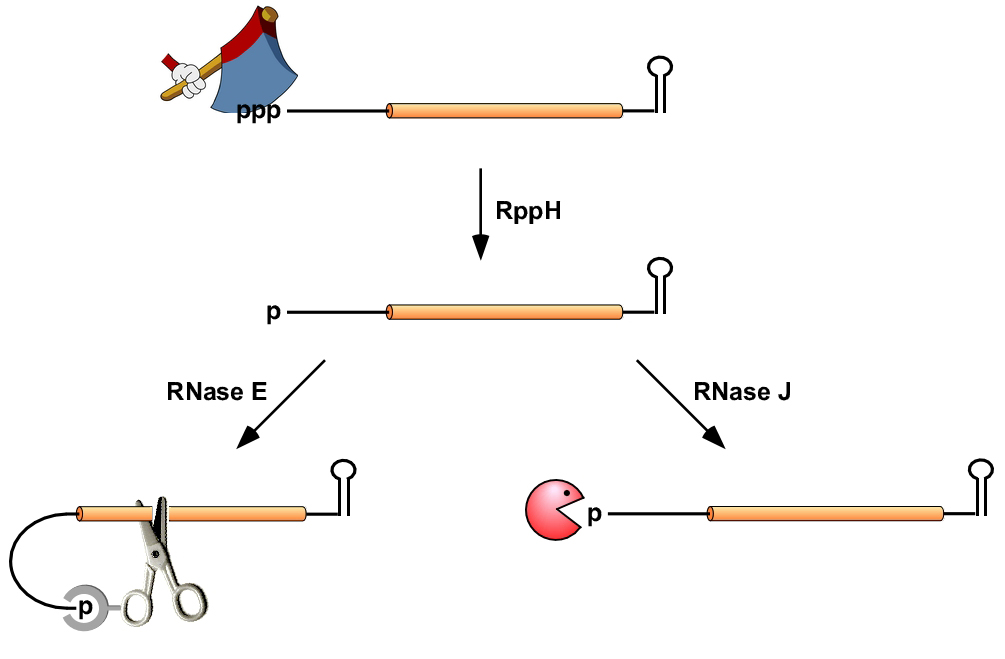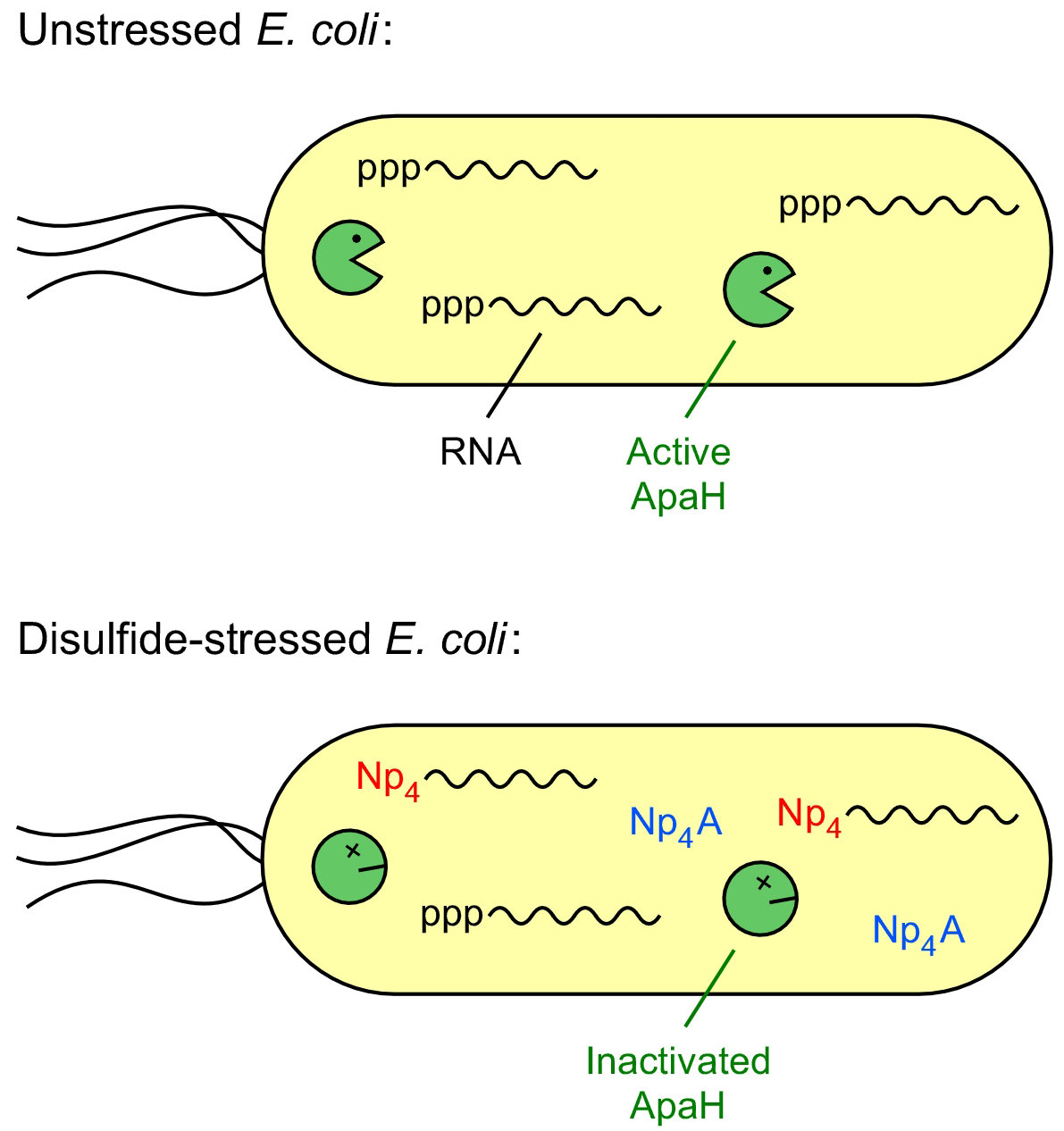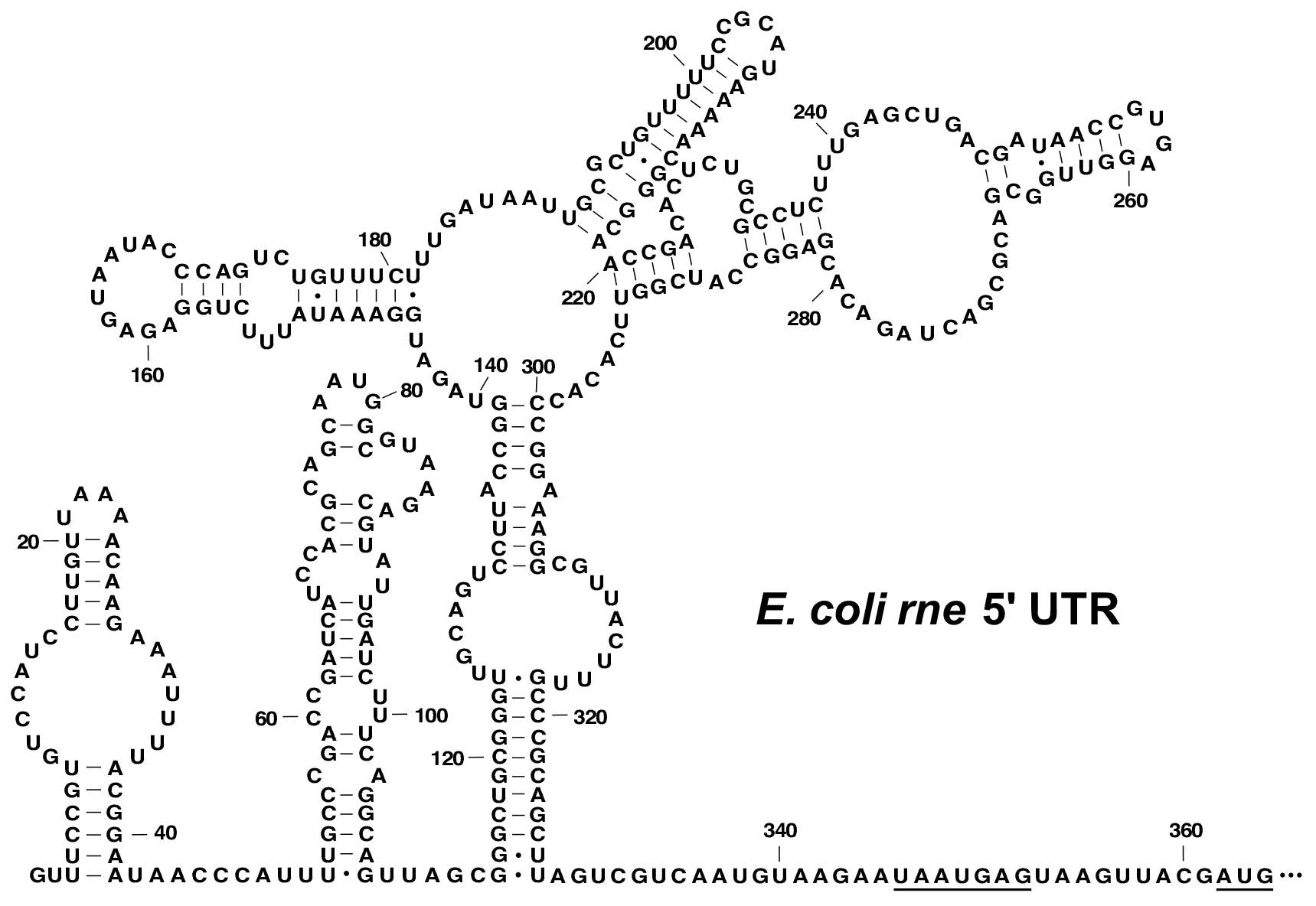
Belasco Lab Research
Investigators in the Belasco Lab use sophisticated methods to further our understanding of RNA biology and post-transcriptional mechanisms of gene regulation. Our areas of focus include 5´-terminal deprotection of mRNA, nucleoside tetraphosphate caps, linear scanning by RNase E, and RNase E autoregulation.
5´-Terminal Deprotection of mRNA
In bacteria, the lifetimes of individual mRNAs can differ by up to two orders of magnitude, with profound consequences for gene expression. For many years it had been assumed that bacterial mRNA degradation always begins with endonucleolytic cleavage at internal sites. However, our findings have overturned that view by showing that mRNA decay is often triggered by a prior non-nucleolytic event that marks transcripts for rapid turnover: the stepwise conversion of the 5´ terminus from a triphosphate to a monophosphate.
In Escherichia coli and related organisms, this modification creates better substrates for the endonuclease RNase E, whose cleavage activity is greatly enhanced when the RNA 5´ end is monophosphorylated, whereas in Bacillus subtilis and other bacterial species that lack RNase E, it enables 5´-exonucleolytic degradation by RNase J.

We have discovered and characterized a family of RNA pyrophosphohydrolases (RppH) crucial for phosphate removal from the 5´ terminus. The inability of RppH to bind monophosphorylated 5´ ends that are structurally sequestered by a stem-loop helps to explain the stabilizing influence of 5´-terminal base pairing on mRNA lifetimes in vivo. Interestingly, this master regulator of 5´-end-dependent mRNA degradation in bacteria not only catalyzes a process functionally reminiscent of eukaryotic mRNA decapping but also bears an evolutionary relationship to the eukaryotic decapping enzyme Dcp2.
Current efforts are aimed at identifying the E. coli RNA triphosphatase(s) whose action stimulates subsequent β phosphate removal by RppH and elucidating the mechanism by which a metabolic enzyme important for cell wall synthesis enhances the catalytic activity of RppH.
Nucleoside Tetraphosphate Caps
The biological function of dinucleoside tetraphosphates (Np4As) has largely remained a mystery since their discovery more than 50 years ago. Present in all realms of life, they have long been thought to function as second messengers. However, no receptor that mediates their influence has ever been identified in bacteria.
We have discovered that, under stress conditions that elevate cellular Np4A concentrations, diverse E. coli mRNAs and sRNAs acquire a novel nucleoside tetraphosphate (Np4) cap. Removal of these caps by either of two pyrophosphatases triggers rapid RNA degradation in E. coli.

Interestingly, the predominant decapping enzyme, ApaH, functions as both a sensor and an effector of cell stress, which inactivates it. These findings suggest that the striking physiological changes heretofore attributed to Np4A signaling via a hypothetical receptor may well result instead from widespread Np4 capping, leading to altered RNA lifetimes and consequent changes in gene expression. We are now seeking to elucidate how Np4 caps are acquired and the mechanism by which ApaH responds to stress.
Linear Scanning by RNase E
The diverse lifetimes of bacterial mRNAs seem difficult to reconcile with the relaxed cleavage-site specificity of RNase E, a key regulatory endonuclease that can cut most single-stranded regions of RNA. Mounting evidence indicates that, in E. coli, rates of mRNA decay are determined not by the number or intrinsic quality of internal cleavage sites but rather by the ease with which RNase E can gain access to them.
We have recently discovered that RNase E locates cleavage sites in monophosphorylated RNA by a novel monorail-like mechanism involving linear diffusion from the 5´ terminus along RNA segments that are single-stranded. Consequently, the rate of cleavage at those internal sites is governed not only by the ability of RNase E to initially bind the 5´ end but also by any obstacles that this endonuclease may encounter as it scans downstream.

We are now investigating the mechanism of scanning, the features of RNase E that enable it to diffuse linearly on RNA, and the characteristics of obstacles that determine their efficacy.
RNase E Autoregulation
RNase E is an essential regulatory enzyme whose overproduction or underproduction can impair cell growth. To ensure a steady supply of this protein, E. coli has evolved a homeostatic mechanism for tightly regulating its synthesis by modulating the decay rate of rne (RNase E) mRNA in response to changes in cellular RNase E activity.

Our studies have shown that feedback regulation by RNase E is mediated by the 361-nucleotide by the 361-nucleotide rne 5´ untranslated region (UTR), which can confer this property onto heterologous messages to which it is fused. The rne 5´ UTR is composed of several structural domains, two of which play critical roles in feedback regulation. However, these two domains are not themselves cleavage sites. We now wish to determine the mechanism by which they expedite RNase E cleavage elsewhere within the transcript and thereby control rne gene expression.